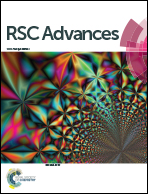The origin of regio- and stereoselectivity in the 1,3-dipolar cycloaddition of nitrile oxides with C1-substituted 7-oxabenzonorbornadienes, a DFT study†
Abstract
In this computational study, density functional theory (DFT) calculations were performed in order to achieve a deep understanding of the regio- and stereoselectivity of 1,3-dipolar cycloadditions (1,3-DC) of C1-substituted 7-oxabenzonorbornadienes (OBNDs) (2a–2d) with acetonitrile oxide (1a) and benzonitrile oxide (1b). The potential energy surface analysis, Wiberg bond orders (BOs) and global electron density transfer (GEDT) at the transition states (TSs) show that these cycloadditions take place through a low asynchronous one-step mechanism with non-polar character. Mechanism studies show that these reactions are exo-stereoselective and anti-regioselective (3X) and classified as (pseudodiradical) pr-type 1,3-DC reactions. These results are in excellent agreement with the experimental observations. A distortion-interaction model has been used successfully for understanding regio- and stereoselectivity in these reactions.


 Please wait while we load your content...
Please wait while we load your content...